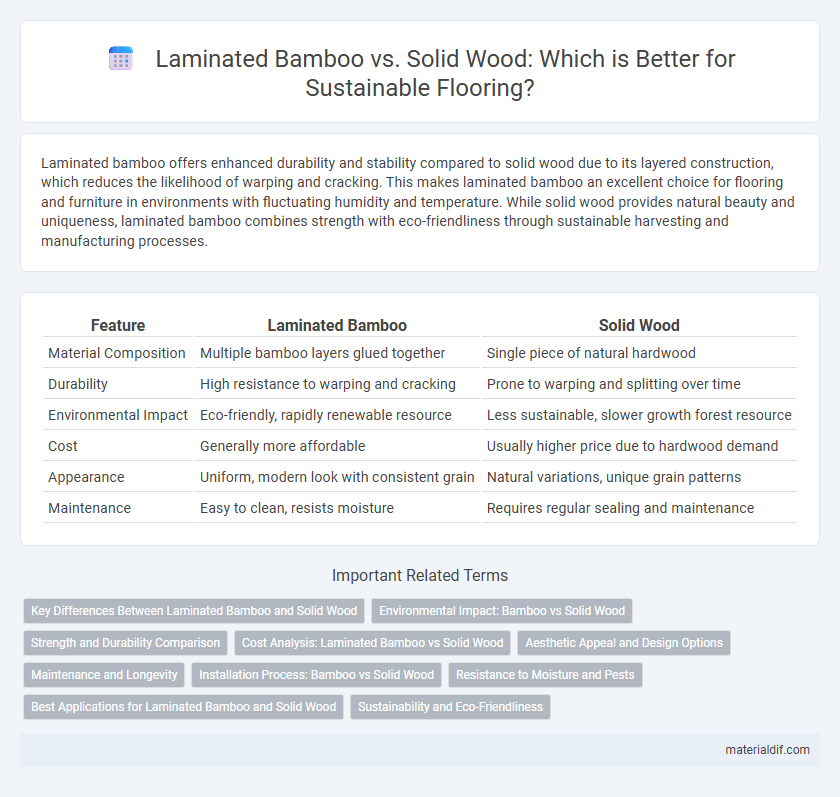Laminated bamboo offers enhanced durability and stability compared to solid wood due to its layered construction, which reduces the likelihood of warping and cracking. This makes laminated bamboo an excellent choice for flooring and furniture in environments with fluctuating humidity and temperature. While solid wood provides natural beauty and uniqueness, laminated bamboo combines strength with eco-friendliness through sustainable harvesting and manufacturing processes.
Table of Comparison
| Feature | Laminated Bamboo | Solid Wood |
|---|---|---|
| Material Composition | Multiple bamboo layers glued together | Single piece of natural hardwood |
| Durability | High resistance to warping and cracking | Prone to warping and splitting over time |
| Environmental Impact | Eco-friendly, rapidly renewable resource | Less sustainable, slower growth forest resource |
| Cost | Generally more affordable | Usually higher price due to hardwood demand |
| Appearance | Uniform, modern look with consistent grain | Natural variations, unique grain patterns |
| Maintenance | Easy to clean, resists moisture | Requires regular sealing and maintenance |
Key Differences Between Laminated Bamboo and Solid Wood
Laminated bamboo consists of multiple layers of bamboo strips bonded with adhesives, offering enhanced stability, moisture resistance, and uniformity compared to solid wood, which is a single piece of natural timber prone to expansion and contraction. Solid wood typically provides a more traditional aesthetic with natural grain variations, while laminated bamboo features consistent patterns and increased durability due to its engineered structure. The sustainability of laminated bamboo is often superior, as bamboo grows faster than hardwood trees used for solid wood, making it an eco-friendly choice for flooring and furniture.
Environmental Impact: Bamboo vs Solid Wood
Laminated bamboo offers a significantly lower environmental impact compared to solid wood due to its rapid growth rate and renewability, with bamboo reaching maturity in 3-5 years versus decades for most hardwoods. Bamboo cultivation requires fewer pesticides and less water, reducing soil degradation and deforestation typically associated with solid wood harvesting. Additionally, laminated bamboo production often utilizes the entire stalk, minimizing waste and enhancing sustainability compared to solid wood processing.
Strength and Durability Comparison
Laminated bamboo offers superior strength compared to solid wood due to its cross-layer construction, which enhances resistance to warping and splitting. Its durability exceeds that of many hardwoods, making it ideal for high-traffic flooring and furniture applications. Solid wood, while naturally strong, can be more susceptible to environmental changes causing expansion and contraction over time.
Cost Analysis: Laminated Bamboo vs Solid Wood
Laminated bamboo generally offers a more cost-effective option compared to solid wood, with prices typically 20-40% lower due to faster growth rates and efficient production processes. Solid wood's higher cost results from longer growth times, labor-intensive harvesting, and greater waste during milling. Maintenance expenses also differ, as laminated bamboo requires less frequent refinishing, reducing long-term costs compared to solid hardwood floors.
Aesthetic Appeal and Design Options
Laminated bamboo offers a consistent grain pattern and a modern aesthetic that enhances contemporary interior designs, while solid wood displays natural variations and unique knots that add character and warmth to traditional settings. The engineered layers in laminated bamboo allow for greater dimensional stability and can be produced in various colors and finishes, expanding design versatility. Solid wood's organic texture and ability to be refinished multiple times provide timeless appeal, but laminated bamboo's sustainable sourcing and customizable appearance make it an increasingly popular choice in eco-friendly architecture.
Maintenance and Longevity
Laminated bamboo offers superior resistance to moisture and temperature fluctuations compared to solid wood, resulting in lower maintenance requirements and enhanced durability over time. Its engineered layers provide stability that reduces warping and cracking, extending the lifespan of flooring and furniture. Solid wood demands regular sealing and refinishing to protect against environmental damage, whereas laminated bamboo maintains its integrity with minimal upkeep.
Installation Process: Bamboo vs Solid Wood
Laminated bamboo features a tongue-and-groove design that allows for fast, click-lock installation, reducing the need for adhesives or nails compared to solid wood. Solid wood installation typically requires precise acclimation, cutting, and nailing, which can extend the process and demand skilled labor. Bamboo's engineered structure offers consistent sizing and moisture resistance, simplifying installation in various environments where solid wood might warp or expand.
Resistance to Moisture and Pests
Laminated bamboo offers superior resistance to moisture compared to solid wood due to its engineered structure that minimizes water absorption and swelling. The adhesive layers in laminated bamboo enhance its durability against pests such as termites, unlike solid wood which is more susceptible to insect damage. This makes laminated bamboo a more reliable choice for environments with high humidity and pest exposure.
Best Applications for Laminated Bamboo and Solid Wood
Laminated bamboo excels in flooring, cabinetry, and furniture due to its high strength, durability, and resistance to moisture, making it ideal for high-traffic areas and humid environments. Solid wood is preferred for structural applications, custom furniture, and aesthetic woodwork where natural grain, traditional craftsmanship, and long-term refinishing are prioritized. Both materials offer sustainable solutions, but laminated bamboo provides superior dimensional stability and eco-friendly benefits for modern interiors.
Sustainability and Eco-Friendliness
Laminated bamboo offers superior sustainability compared to solid wood due to its rapid growth rate, requiring fewer resources for cultivation and harvesting. Its manufacturing process utilizes bamboo strips bonded under heat and pressure, maximizing material use and minimizing waste. Unlike solid wood, which often involves deforestation, laminated bamboo supports eco-friendly practices by promoting renewable, biodegradable, and carbon-sequestering materials.
Laminated Bamboo vs Solid Wood Infographic

 materialdif.com
materialdif.com